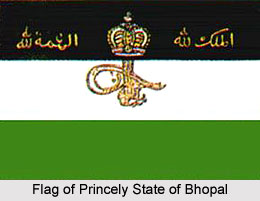 The Princely State of Bhopal was one of the 19 Gun Salute states of India during the rule of the British Empire in India which was administered by native rulers, also known as Indian princes, under the indirect control of the British Government of India. The princely state existed from the year 1818 to 1947. After India achieved independence, the territory attained the statues of an autonomous country until 1949, after which the state was merged with the Dominion of India as Bhopal. The Princely State of Bhopal covered a total area of 6,921.25 sq miles and comprised of a total population of 785,322 in the year 1941. Bhopal was located in the state of Malwa and included 2,946 villages and 17 towns. It was the leading Muslim princely state in Central India Agency and was ranked 2nd in importance to Hyderabad amongst the Indian Muslim states.
The Princely State of Bhopal was one of the 19 Gun Salute states of India during the rule of the British Empire in India which was administered by native rulers, also known as Indian princes, under the indirect control of the British Government of India. The princely state existed from the year 1818 to 1947. After India achieved independence, the territory attained the statues of an autonomous country until 1949, after which the state was merged with the Dominion of India as Bhopal. The Princely State of Bhopal covered a total area of 6,921.25 sq miles and comprised of a total population of 785,322 in the year 1941. Bhopal was located in the state of Malwa and included 2,946 villages and 17 towns. It was the leading Muslim princely state in Central India Agency and was ranked 2nd in importance to Hyderabad amongst the Indian Muslim states.
The territory was bounded by the Sironj district of Tonk, Bhilsa and Isagarh districts of Gwalior and Muhammadgarh in the north; by the British district of Saugor in the east; by the British districts of Hoshangabad and Narsinghpur (all in the Central Provinces and Berar) in the south; and the Shajapur district of Gwalior in the west; and by Narsighgarh and Rajgarh in the north-west. It was a part of the Bhopal Agency under the Central India Agency.
History of Princely State of Bhopal
The initial capital of the state was at Islamnagar, which was later moved to the city of Bhopal. The state was established by Dost Mohammad Khan, a Mughal soldier. After the death of the Mughal emperor Aurangzeb, he became a mercenary and annexed various regions to his feudal territory. In the year 1724, the princely state of Bhopal accepted the suzerainty of the Nizam of Hyderabad. Later in 1818, it came under the protection of the British Government of India. During the great revolt of 1857, Sikander Begum, the then ruler of Bhopal, provided support to British East India Company, as per the treaty of 1818. The rebellion in the state of Bhopal and the surrounding areas was repressed by Sikander Begum in its preliminary stages. The state comprised of an army, which was under the direct command of British officers. It was developed under the Anglo Bhopal treaty of 1818 and comprised of 600 cavalry and 400 infantry.
Bhopal State was honoured a one of the Salute States of India with a gun salute of 19 guns. The courts of the state exercised full civil and criminal jurisdiction. The native ruler of the state held the title of Nawab and took charge of the administration of the princely state. Moreover a partially elective Legislative Council was set up in the year 1927. The territory was divided into 3 nizamats for administrative purposes. In 1897, the British rupee became the only recognized legal tender.
After India achieved independence on August 15, 1947, Bhopal was one of the last Indian princely states to sign the Instrument of Accession after the nation attained independence from the dominion of the British Government of India on August 15, 1947. Due to the Indian Independence Act 1947, all the Indian princely states were released from their treaty obligations to the British administration and had to decide whether to merge with the new dominions of India or Pakistan. On 1 June 1949, the princely state Bhopal was taken over by the Union of India. The new Bhopal State was declared a Part C state, governed by a chief commissioner appointed by the Indian President.
Rulers of Princely State of Bhopal
Nawab Dost Mohammad Khan (1723- 1728)
Nawab Yar Mohammad Khan (1728- 1742)
Nawab Faiz Mohammad Khan (1742- 1777)
Nawab Hayat Mohammad Khan (1777- 1807)
Nawab Ghous Mohammad Khan (1807- 1826)
Nawab Wazir Mohammad Khan (1807- 1816)
Nawab Nazar Mohammad Khan, son of Wazir Mohammad Khan (1816- 1819)
Nawab Sultan Qudsia Begum (1819- 1837)
Nawab Jahangir Mohammad Khan (1837- 1844)
Nawab Sikander Jahan Begum (1860- 1868)
Nawab Sultan Shah Jahan Begum (1844- 1860 and 1868- 1901)
Nawab Sultan Kaikhusrau Jahan Begum (1901- 1926)
Nawab Hamidullah Khan (1926- 1949)



















